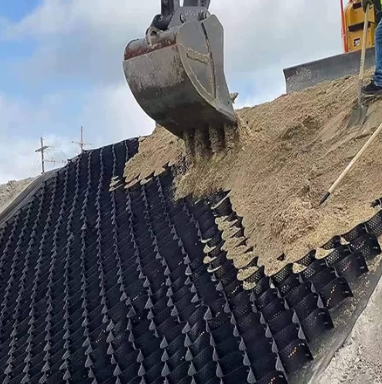- Understanding the Role of Geomembrane Liners in Waste Management
- Innovations in Geomembrane Liners for Water Management
- Geomembrane Liners: A Comprehensive Guide
- The Future of Geomembrane Liners in Civil Engineering
- Geomembrane Liners: Enhancing Landfill Stability
Manager:Alvin Wang
WhatsApp:+62 8983806051
Tel:+86 10-5797-1075
Email:steelwang@okorder.com
Address:3rd Floor, No.2 Building, No.1 Sanlihe Road
How is Geocell manufactured?
Geocell slope protection has become an integral component in civil engineering projects aimed at mitigating soil erosion and stabilizing slopes. These honeycomb-like structures, also known as slope protection geocells, offer an innovative solution to reinforce soil, prevent erosion, and promote sustainable development in various applications such as road construction, riverbank protection, and landscaping.

Introduction to Geocell Slope Protection
Geocell slope protection systems consist of interconnected cells made from high-density polyethylene (HDPE) or other polymers. These cells are filled with soil, aggregate, or concrete, forming a stable structure that enhances the load-bearing capacity of weak soils and prevents surface erosion.
Raw Materials and Manufacturing Process
The manufacturing process of geocell slope protection involves several stages, starting with the selection of raw materials. High-quality HDPE or other suitable polymers are chosen for their durability, flexibility, and resistance to environmental factors such as UV radiation and chemical exposure.
Extrusion
Extrusion is a key step in the production of geocells. The selected polymer is melted and extruded through a die to form flat sheets with uniform thickness. These sheets are then passed through a series of rollers to create the desired cell geometry, typically hexagonal or octagonal, with integral walls.
Texturing
Texturing is essential to enhance the interlocking capabilities of geocell walls. Specialized texturing processes, such as heat embossing or knurling, create rough surfaces on the cell walls, facilitating better soil retention and interlocking during installation.
Welding
Once the textured sheets are formed, they undergo welding to create the final three-dimensional geocell structure. High-frequency welding or thermal fusion techniques are employed to join adjacent panels securely, ensuring structural integrity and dimensional stability.
Expansion
After welding, the flat geocell panels undergo expansion to form the characteristic three-dimensional honeycomb structure. This expansion process involves stretching the panels both longitudinally and laterally to achieve the desired cell size and geometry.
Quality Control and Testing
Throughout the manufacturing process, rigorous quality control measures are implemented to ensure the integrity and performance of the geocell slope protection products. Quality control tests, including dimensional checks, tensile strength evaluations, and UV resistance assessments, are conducted to verify compliance with industry standards and specifications.
Advantages of Geocell Slope Protection
Geocell slope protection offers numerous advantages over traditional erosion control methods:
1. Enhanced Stability: The three-dimensional structure of geocells provides increased stability and load-bearing capacity, minimizing soil displacement and erosion.
2. Flexibility: Geocells conform to irregular terrain and slope contours, making them suitable for a wide range of applications, including steep slopes, embankments, and channels.
3. Environmental Benefits: By promoting vegetation growth and reducing erosion, geocell slope protection contributes to environmental conservation efforts and sustainable land development practices.
4. Cost-Effectiveness: Compared to conventional slope stabilization techniques, geocell systems offer a cost-effective solution with lower material and labor requirements, shorter construction timelines, and reduced maintenance costs.
Applications of Slope Protection Geocell
Slope protection geocells find diverse applications in civil engineering and infrastructure projects:
1. Road and Highway Embankments: Geocell slope protection is commonly used to reinforce road and highway embankments, preventing soil erosion and slope failures while improving road safety and longevity.
2. Riverbank and Shoreline Protection: Geocells are employed to stabilize riverbanks, shorelines, and coastal areas, mitigating the effects of erosion, wave action, and sediment transport.
3. Landscaping and Retaining Walls: Geocell systems offer versatile solutions for landscaping projects, including retaining walls, green roofs, and slope greening applications, enhancing aesthetics and environmental sustainability.
4. Mining and Landfill Rehabilitation: In mining and landfill rehabilitation projects, geocell slope protection helps restore disturbed land areas, minimize soil erosion, and promote revegetation, facilitating ecosystem recovery and land reclamation.

Conclusion
Geocell slope protection represents a cutting-edge solution for soil erosion control, slope stabilization, and environmental conservation. By leveraging advanced manufacturing techniques and high-performance materials, geocell systems offer a versatile, cost-effective, and sustainable approach to mitigating erosion, enhancing soil stability, and promoting responsible land development practices. As the demand for innovative erosion control solutions continues to grow, geocell slope protection is poised to play a pivotal role in shaping the future of civil engineering and infrastructure development worldwide."






